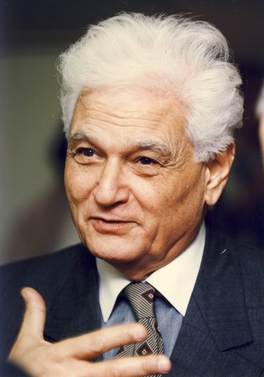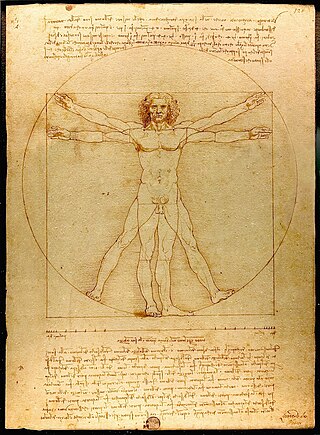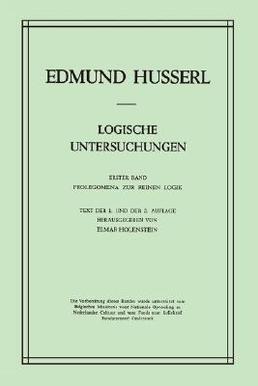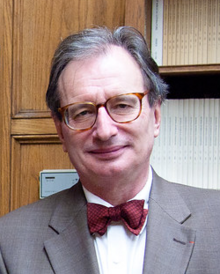
Edmund Gustav Albrecht Husserl was an Austrian-German philosopher and mathematician who established the school of phenomenology.

Maurice Jean Jacques Merleau-Ponty was a French phenomenological philosopher, strongly influenced by Edmund Husserl and Martin Heidegger. The constitution of meaning in human experience was his main interest and he wrote on perception, art, politics, religion, biology, psychology, psychoanalysis, language, nature, and history. He was the lead editor of Les Temps modernes, the leftist magazine he established with Jean-Paul Sartre and Simone de Beauvoir in 1945.

Jacques Derrida was a French philosopher. He developed the philosophy of deconstruction, which he utilized in a number of his texts, and which was developed through close readings of the linguistics of Ferdinand de Saussure and Husserlian and Heideggerian phenomenology. He is one of the major figures associated with post-structuralism and postmodern philosophy although he distanced himself from post-structuralism and disowned the word "postmodernity".

Phenomenology is the philosophical study of objectivity and reality as subjectively lived and experienced. It seeks to investigate the universal features of consciousness while avoiding assumptions about the external world, aiming to describe phenomena as they appear to the subject, and to explore the meaning and significance of the lived experiences.

Emmanuel Levinas was a French philosopher of Lithuanian Jewish ancestry who is known for his work within Jewish philosophy, existentialism, and phenomenology, focusing on the relationship of ethics to metaphysics and ontology.
Continental philosophy is typically a term used as an umbrella term for philosophies prominent in continental Europe. Michael E. Rosen has ventured to identify common themes that typically characterize continental philosophy. These themes proposed by Rosen derive from a broadly Kantian thesis that knowledge, experience, and reality are bound and shaped by conditions best understood through philosophical reflection rather than exclusively empirical inquiry.

Being and Time is the 1927 magnum opus of German philosopher Martin Heidegger and a key document of existentialism. Being and Time is among the most influential texts of 20th century philosophy. It had a notable impact on subsequent philosophy, literary theory and many other fields. Though controversial, its stature in intellectual history has been compared with works by Kant and Hegel. The book attempts to revive ontology through an analysis of Dasein, or "being-in-the-world." It is also noted for an array of neologisms and complex language, as well as an extended treatment of "authenticity" as a means to grasp and confront the unique and finite possibilities of the individual.
Existential phenomenology encompasses a wide range of thinkers who take up the view that philosophy must begin from experience like phenomenology, but argues for the temporality of personal existence as the framework for analysis of the human condition.
The phenomenology of religion concerns the experiential aspect of religion, describing religious phenomena in terms consistent with the orientation of worshippers. It views religion as made up of different components, and studies these components across religious traditions in order to gain some understanding of them.

Philosophical anthropology, sometimes called anthropological philosophy, is a discipline dealing with questions of metaphysics and phenomenology of the human person.
Phenomenology or phenomenological psychology, a sub-discipline of psychology, is the scientific study of subjective experiences. It is an approach to psychological subject matter that attempts to explain experiences from the point of view of the subject via the analysis of their written or spoken words. The approach has its roots in the phenomenological philosophical work of Edmund Husserl.

Phenomenology within sociology, or phenomenological sociology, examines the concept of social reality as a product of intersubjectivity. Phenomenology analyses social reality in order to explain the formation and nature of social institutions. The application of phenomenological ideas in sociology differs from other social science applications of social science applications.
Dermot Moran is an Irish philosopher specialising in phenomenology and in medieval philosophy, and he is also active in the dialogue between analytic and continental philosophy. He is currently the inaugural holder of the Joseph Chair in Catholic Philosophy at Boston College. He is a member of the Royal Irish Academy and a founding editor of the International Journal of Philosophical Studies.

Speech and Phenomena: And Other Essays on Husserl's Theory of Signs, or Voice and Phenomenon: Introduction to the Problem of the Sign in Husserl's Phenomenology, is a book about the phenomenology of Edmund Husserl by the French philosopher Jacques Derrida, published in 1967 alongside Derrida's Of Grammatology and Writing and Difference. In Speech and Phenomena, Derrida articulates his mature relationship to Husserl, putting forward an argument concerning Husserl's phenomenological project as a whole in relation to a key distinction in Husserl's theory of language in the Logical Investigations (1900–1901) and how this distinction relates to his description of internal time consciousness. Derrida also develops key discussions of the terms deconstruction and différance. Derrida commented that Speech and Phenomena is the "essay I value the most". Derrida's best known work on Husserl's phenomenology, it is widely considered one of his most important philosophical works.
Phenomenological description is a method of phenomenology that attempts to depict the structure of first person lived experience, rather than theoretically explain it. This method was first conceived of by Edmund Husserl. It was developed through the latter work of Martin Heidegger, Jean-Paul Sartre, Emmanuel Levinas and Maurice Merleau-Ponty — and others. It has also been developed with recent strands of modern psychology and cognitive science.

The Logical Investigations is a two-volume work by the philosopher Edmund Husserl, in which the author discusses the philosophy of logic and criticizes psychologism, the view that logic is based on psychology.
Early phenomenology refers to the early phase of the phenomenological movement, from the 1890s until the Second World War. The figures associated with the early phenomenology are Edmund Husserl and his followers and students, particularly the members of the Göttingen and Munich Circles, as well as a number of other students of Carl Stumpf and Theodor Lipps, and excludes the later existential phenomenology inspired by Martin Heidegger. Early phenomenology can be divided into two theoretical camps: realist phenomenology, and transcendental or constitutive phenomenology.

Burt C. Hopkins is an American philosopher. He is an Associate Member of the University of Lille, Permanent Faculty member of the Summer School of Phenomenology and Phenomenological Philosophy, Ca' Foscari University of Venice, former Professor and Chair of Philosophy at Seattle University (1989-2016) and Permanent Secretary of the Husserl Circle.

Jean-Louis Chrétien was a French philosopher in the tradition of phenomenology as well as a poet and religious thinker. Author of over thirty books, he was the 2012 winner of the Cardinal Lustiger Prize for his life’s work in philosophy. He was professor emeritus of philosophy at the Sorbonne at the end of his career. The study of Chrétien increased widely after his death, a posthumous recognition that contrasts with his modest and solitary attitude.













